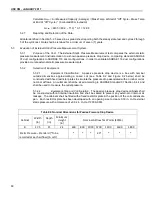
USE OM - JANUARY 2017
57
Where;
Q
SC
= corrected air flow rate
5.1.7
Reporting and Retention of the Data.
All data identified in Section 5.1.5 and all calculations in Section 5.1.6 shall be reported for each test. Data shall
be retained for a minimum of seven (7) years.
5.2
Evaluation of Thermal Energy Storage Effect for C
D
Testing
.
5.2.1
Purpose of the Test
. This Thermal Energy Storage Effect Test measures the thermal energy storage
of the air flow rate measuring apparatus in order to accurately determine the cyclic capacity of the dry coil as
specified in Section 9.2 of ASHRAE Standard 116 (e.g. the cyclic test for single stage product in AHRI Standard
210/240).
5.2.2
Selection of Equipment
.
5.2.2.1
Equipment Classification.
The UUT for the Thermal Energy Storage Effect Test shall
be the same split system air-handler with electric heat capability used in Section 5.1 or the purpose
built heater box.
5.2.2.2
Equipment Size and Configuration
. The production equipment design shall be fitted
with an electric heat module of at least 2 kW per maximum ton located at the outlet of the air-handler.
A purpose built heater box with the same electrical specification may be used. The UUT wiring must
be modified so that electrical energy supplied to the heater may be varied separately from electrical
energy supplied to the rest of the UUT. Typically the psychrometric Outdoor Room power supply and
measurement equipment will need to be used due to relatively high power requirements. Individual
banks shall have the capability of being switched
“on” and “off” independently.
5.2.3
Test Setup.
5.2.3.1
The UUT shall be set up in the Indoor Room in accordance with ASHRAE Standard
37 Section 6.4 through Section 6.6.
5.2.3.2
All indoor electrical energy shall be measured with instrumentation which is in
accordance with Section 5.4 of ASHRAE Standard 37.
5.2.3.3
If an indoor volatile refrigerant coil is present in the UUT it shall be void of refrigerant
charge in order to eliminate any thermal siphoning.
5.2.3.4
The leaving thermocouple grid (or thermopile) must not be affected by the radiant
energy coming from the heater element. Verified by the following:
5.2.3.4.1
Set the room temperature to 90°F. Run the air through the apparatus with
no electric heat energized and record the difference in temperatures between the
leaving grids and RTDs in the psychrometers (four independent readings shall be
taken).
5.2.3.4.1.1
For thermocouple grids or thermopiles, set the room
temperature to 70°F. Apply enough power to the heater to raise the air
temperature approximately 20R°. If the difference between the grids and
the RTDs vary by more than 1R°, then shield or block the line of sight
between the heater and thermocouples.
















































